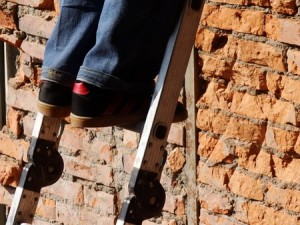Precarious Situations: Why Ladders Cause So Many Injuries
 Do you use a ladder at your job? Whether it is just once in a while or as part of your everyday job duties, one mistake can result in a serious fall.
Do you use a ladder at your job? Whether it is just once in a while or as part of your everyday job duties, one mistake can result in a serious fall.
Falls are among the most common types of work-related injuries, and many of these occur on step ladders, expansion ladders, straight ladders, and combination ladders. Approximately 90,000 people are treated in the emergency room for ladder-related falls each year, and almost 1,000 of those falls are fatal. Even if you are comfortable getting up on a ladder as part of your job, accidents can happen to anyone.
Jobs with the Highest Risk for Falls
Not surprisingly, the occupations most at risk for a fall from a ladder include roofers, painters, electricians, construction workers, service and repair technicians, and other skilled trades that require physical labor, climbing, and lifting. However, people who work in other industries can also be at risk for a fall. Retail workers and warehouse or distribution center employees who use ladders to stock shelves or put up displays can become seriously hurt from a ladder fall, especially if they are not properly trained to use the equipment. Even office workers can suffer a fall from a step ladder and end up with a serious injury.
The Most Common Causes of Ladder Falls
1. The most easily preventable cause of ladder falls is improper use of the equipment. Most ladders have instructions for correct use printed right on them. A good rule of thumb is the Three Points of Contact Rule. When climbing a ladder, always maintain three points of contact with the ladder in order to minimize your chances of falling off. A ladder that is placed on uneven ground or against an unsteady wall is not safe.
2. Nearly half of all ladder-related falls occurred when someone was attempting to carry items as they climbed
3. Using the wrong type of ladder for the job can be dangerous, so make sure you’re using the right ladder for the job and for you. Consider the ladder’s height and its weight capacity. If the ladder you have isn’t quite what you need, don’t use it.
4. Sometimes even when you are very careful, accidents can still happen. Something may be wrong with the ladder itself. Wear and tear can make a ladder unsafe, so always check the equipment for cracks or damages before climbing onto it. If the ladder is defective (for instance, if it fails to lock into place), the manufacturer may be liable for your injuries.
OSHA tips for being safe at work:
In addition to the Three Points of Contact Rule, there are several other ways to minimize your chances of suffering a painful ladder fall. The Occupational Safety and Health Administration (OSHA) has published a list of best practices all workers should know. Some of these include:
- Notice the labels/instructions marked on the ladder and follow them
- Take a look at the ladder closely before climbing it. Check for loose or damaged rungs and parts
- Be sure all locks on an extension ladder are properly engaged
- Do not exceed the maximum weight limit on a ladder
- Do not overreach while on a ladder
- Do not attempt to move a ladder while you or someone else is on it
- Wear slip-resistant shoes
If you have been hurt in a fall or any other type of work injury, you might need help getting the benefits you are owed under Pennsylvania law. It can be a complicated process, especially if your claim is denied. Contact Munley Law Personal Injury Attorneys to arrange a FREE consultation with a workers’ compensation lawyer who will answer your questions and help you determine the next steps to take. Fill out our online contact form or call us at 855-866-5529. There is no fee unless we obtain benefits for you.
Posted in Workers' Compensation.










